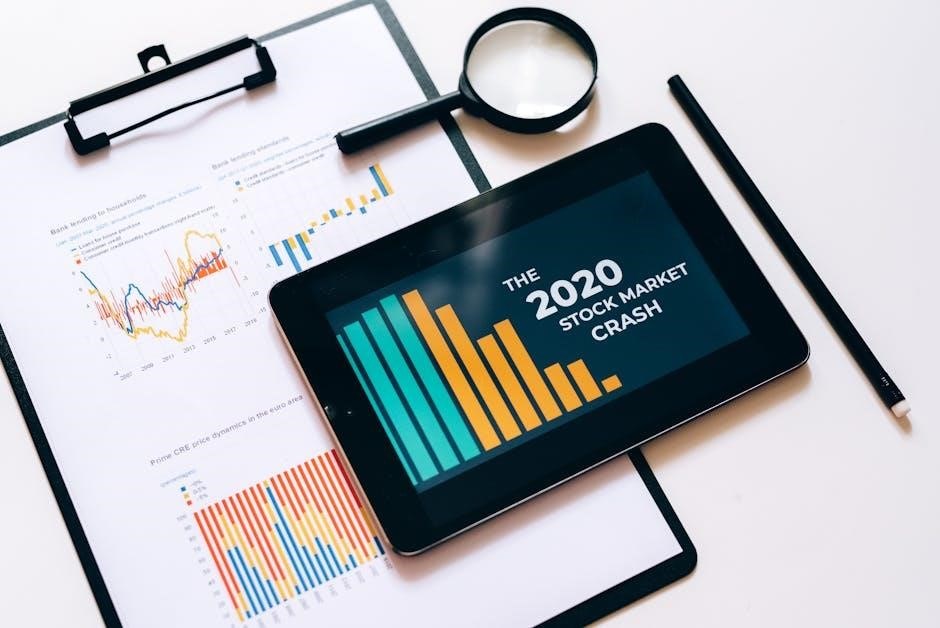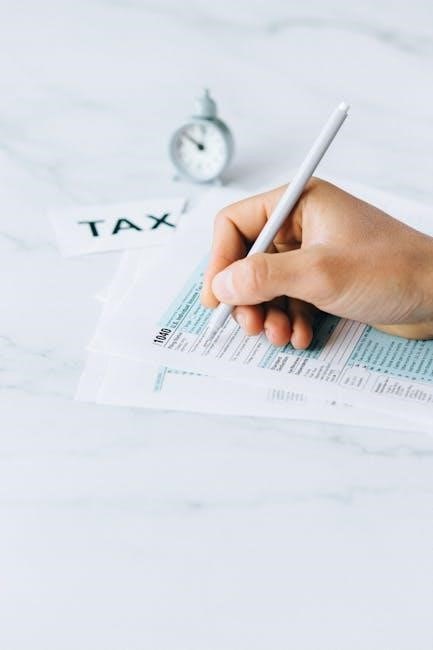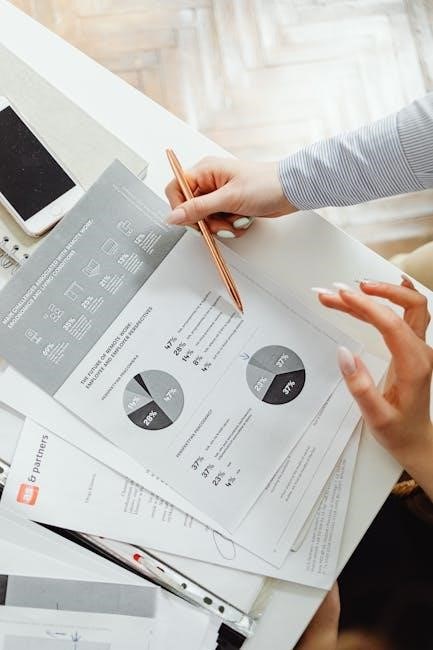Applied Statistics for Business and Economics PDF: An Overview
Applied Statistics for Business and Economics merges statistical theory with real-world applications. It provides tools for data analysis, informed decisions, and insights. The PDF format offers accessibility and convenience for learners and professionals.
Definition of Statistics in Business and Economics
Statistics in business and economics involves collecting, analyzing, interpreting, and presenting data to support decision-making. It encompasses both descriptive methods, summarizing data, and inferential techniques, drawing conclusions about populations based on samples. In a business context, statistics helps analyze market trends, consumer behavior, and operational efficiency. Economically, it aids in forecasting, modeling economic phenomena, and evaluating policy impacts. The field emphasizes data-driven insights, enabling informed strategies and improved outcomes. Statistical methods provide a structured approach to understanding complex datasets, identifying patterns, and quantifying uncertainty. This allows businesses and economists to make predictions, assess risks, and optimize resource allocation. Applied statistics is crucial for evidence-based decision-making in both sectors.
The Role of Applied Statistics in Decision Making
Applied statistics plays a pivotal role in decision-making across business and economics by transforming raw data into actionable insights. It provides tools to analyze trends, forecast outcomes, and assess risks, enabling informed choices. In business, statistical analysis supports decisions related to marketing strategies, operational efficiency, and financial planning. Economists use applied statistics to model economic behavior, evaluate policy effectiveness, and predict market fluctuations. By quantifying uncertainty and identifying patterns, statistics helps decision-makers minimize risks and maximize opportunities. It ensures decisions are based on empirical evidence rather than intuition or guesswork. Statistical methods offer a structured approach to problem-solving, allowing for objective evaluation of alternatives. Ultimately, applied statistics empowers businesses and economists to make data-driven decisions that lead to improved performance and outcomes.
Key Concepts in Applied Statistics
Key concepts involve understanding data collection, descriptive statistics, and inferential techniques. These concepts are essential for analyzing business trends, making informed predictions, and supporting economic decision-making processes effectively.
Descriptive Statistics
Descriptive statistics involves summarizing and presenting data in a meaningful way. This includes using measures such as mean, median, and mode to describe central tendency. Variance and standard deviation quantify data spread.
Frequency distributions and histograms visually represent data patterns. Charts and graphs aid interpretation. In business, descriptive statistics help understand customer demographics, sales trends, and operational efficiency. It provides a clear overview of the data, enabling informed decisions.
It condenses large datasets into digestible summaries. It helps identify patterns. Though descriptive, this summary sets the basis for further analysis. In economics, this is used to show unemployment, inflation, and other macro-economic indicators. This is the first step to data analysis.
Inferential Statistics
Inferential statistics uses sample data to make inferences about populations. It includes hypothesis testing and confidence intervals. These methods allow businesses to draw conclusions beyond the immediate dataset.
Hypothesis testing assesses the validity of claims about a population. Confidence intervals estimate population parameters with a specified level of certainty. Regression analysis explores relationships between variables, aiding in prediction.
In economics, inferential statistics is vital for econometric modeling. It helps analyze economic trends and forecast future outcomes. Proper application requires understanding assumptions and limitations. These tools enhance decision-making by providing insights into broader patterns. It uses probability to show the likelihood of different outcomes.

Data Collection and Analysis
Data Collection and Analysis involves gathering relevant information and employing statistical techniques. This process transforms raw data into meaningful insights for business and economic decision-making, ensuring informed strategies.
Methods of Data Collection
Effective data collection is crucial in applied statistics for business and economics. Common methods include surveys, experiments, and observational studies. Surveys gather data through questionnaires, while experiments involve manipulating variables to observe effects. Observational studies collect data without intervention.
Sampling techniques, such as random sampling and stratified sampling, ensure representative data. Data can also be sourced from existing databases, company records, and government publications. The choice of method depends on the research question, resources, and desired accuracy. Properly collected data ensures reliable analysis and informed decision-making.
Furthermore, it’s essential to consider ethical considerations during data collection, ensuring privacy and confidentiality. Rigorous planning and execution of data collection methods are vital for obtaining high-quality data, which is the foundation of sound statistical analysis and valid conclusions in business and economics.
Statistical Techniques for Data Analysis
Data analysis in applied statistics for business and economics involves various techniques to extract meaningful insights. Descriptive statistics summarize data using measures like mean, median, and standard deviation. Regression analysis models relationships between variables for prediction and understanding. Hypothesis testing assesses the validity of claims using sample data.
Time series analysis examines data points collected over time to identify trends and patterns. ANOVA (analysis of variance) compares means across multiple groups. Factor analysis reduces the dimensionality of data by identifying underlying factors. Cluster analysis groups similar data points together.
These techniques, along with others, enable businesses and economists to make informed decisions, identify opportunities, and solve problems. Selecting the appropriate technique depends on the data type, research question, and desired outcomes. Proper application and interpretation of these methods are crucial for drawing valid conclusions and supporting evidence-based strategies.

Applications in Business
Applied statistics drive business decisions through data analysis. It supports market research, financial forecasting, and operational optimization. Statistical methods provide insights for strategic planning and competitive advantage in today’s data-driven world.
Market Research and Analysis
Market research relies heavily on applied statistics to gather, analyze, and interpret data related to consumer behavior and market trends. Businesses use surveys, experiments, and observational studies to collect data, which is then analyzed using descriptive and inferential statistics. Descriptive statistics summarize market characteristics while inferential statistics draw conclusions about the larger population.
Statistical techniques, such as regression analysis, help identify factors influencing consumer behavior. Cluster analysis segments markets into distinct groups. Hypothesis testing validates assumptions about market preferences. Market research informs product development, pricing strategies, and promotional campaigns, which are essential business components.
Ultimately, applied statistics empowers businesses to make data-driven decisions, minimize risks, and maximize returns on investment in marketing and sales. Understanding and applying statistical methods is a crucial skill for market researchers and business analysts.
Financial Forecasting
Financial forecasting utilizes applied statistics to predict future financial outcomes, guiding investment decisions and corporate strategies. Time series analysis, a core statistical technique, analyzes historical data to identify patterns and project future values. Regression models explore relationships between financial variables and economic indicators.
Statistical distributions, like the normal distribution, help quantify uncertainty in forecasts. Risk management relies on statistical measures, such as standard deviation and Value at Risk (VaR), to assess potential losses. Scenario analysis incorporates statistical simulations to evaluate different financial outcomes under varying conditions.
Accurate financial forecasting is essential for budgeting, resource allocation, and strategic planning. Businesses use forecasts to estimate revenues, expenses, and profits. Investors rely on forecasts to evaluate investment opportunities and manage portfolio risk. Applied statistics provides essential tools for making informed financial decisions and navigating economic uncertainty.

Applications in Economics
Economics utilizes applied statistics for analyzing markets, modeling economic behavior, and testing economic theories. Statistical methods help economists understand complex relationships and make informed policy recommendations based on empirical evidence.
Econometrics and Statistical Modeling
Econometrics employs statistical methods to analyze economic data, testing theories and forecasting trends. It quantifies relationships between economic variables, aiding in policy evaluation and prediction. Statistical modeling is crucial in econometrics, enabling the creation of frameworks that capture the complexities of economic systems.
Econometric models use regression analysis, time series analysis, and other statistical techniques to estimate parameters and assess the significance of economic relationships. These models provide insights into causal effects, allowing economists to understand how changes in one variable impact others.
Furthermore, statistical modeling helps in forecasting key economic indicators, such as GDP growth, inflation rates, and unemployment levels. This provides valuable information for businesses and policymakers. Econometrics and statistical modeling are thus indispensable tools for economic analysis and decision-making.
Economic Indicators and Analysis
Economic indicators are crucial data points used to assess the health and performance of an economy. These indicators provide insights into various aspects, such as production, employment, inflation, and consumer behavior. Analyzing these indicators helps economists and policymakers understand current economic conditions and forecast future trends.
Key economic indicators include GDP growth, unemployment rate, inflation rate (CPI), interest rates, and consumer confidence indices. GDP growth reflects the overall economic output, while the unemployment rate indicates the labor market’s health. Inflation, measured by the CPI, affects purchasing power and monetary policy.
Statistical analysis of economic indicators involves time series analysis, regression modeling, and forecasting techniques. These methods help identify patterns, trends, and relationships among different indicators, aiding informed decisions.

Resources for Learning Applied Statistics
Learning resources include textbooks offering foundational knowledge and practical applications. Online courses provide structured learning with interactive elements. Tutorials offer focused guidance on specific statistical techniques and software usage.
Textbooks and Academic Materials
Textbooks on applied statistics for business and economics offer a structured, in-depth exploration of statistical concepts and methodologies. They provide a strong foundation in both descriptive and inferential statistics, tailored to business and economic contexts. These resources often include detailed explanations, examples, and practice problems, aiding comprehension and skill development. Key topics covered range from data collection and analysis to regression modeling and forecasting.
Academic materials, such as research papers and journals, supplement textbooks by presenting advanced topics and real-world case studies. They demonstrate the application of statistical methods in diverse business and economic scenarios. Students and professionals can leverage these materials to deepen their understanding and stay current with the latest developments in the field. Accessing a variety of resources ensures a comprehensive and practical learning experience.
Online Courses and Tutorials
Online courses and tutorials provide flexible and accessible pathways for learning applied statistics in business and economics. Platforms like Coursera, edX, and Khan Academy offer structured courses covering fundamental statistical concepts and their applications. These resources often feature video lectures, interactive exercises, and quizzes to enhance learning.
Tutorials, available on websites and YouTube, offer focused guidance on specific statistical techniques. They break down complex topics into manageable steps, ideal for self-paced learning. These resources often include real-world examples and case studies, demonstrating practical applications in business and economics. Learners can gain hands-on experience using statistical software like R or Python. Online learning fosters a dynamic and engaging environment, making applied statistics more accessible to a wider audience.
